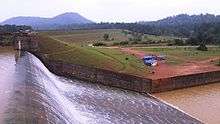Kherkatta Reservoir
| Kherkatta Dam | |
|---|---|
 Floodgates of Kherkatta Dam | |
 Location of Kherkatta Dam in India | |
| Official name | Pakhanjore Reservoir |
| Coordinates | 20°9′17.25″N 80°38′32.21″E / 20.1547917°N 80.6422806°ECoordinates: 20°9′17.25″N 80°38′32.21″E / 20.1547917°N 80.6422806°E |
| Construction began | 1958 |
| Opening date | 1964 |
| Construction cost | 0.08 Crore Rs in 1964 |
| Dam and spillways | |
| Type of dam | Embankment, earth-fill |
| Impounds | Matholi stream |
| Height | 20 m (66 ft) |
| Length | 610 m (2,000 ft) |
| Reservoir | |
| Creates | Kherkatta Reservoir |
| Total capacity | 2,955,000 m3 (2,396 acre·ft) |
Kherkatta Reservoir, also known as Pakhanjore Reservoir,[1] is a man-made lake about 12 km (7.5 mi) north of Pakhanjore in Chhattisgarh, India. It was constructed by the Dandakaranya Development Authority under the project Dandakaranya Project[2] in 1958 to assist the refugees who sought a place to settle. Kherkatta is a Hindi word which means "Land of energy".[3]
The Kherkatta Reservoir (Kherkatta Dam)[4] was constructed over an area of 1,300 acres over an estimated cost of Rs 0.08 crores. The year of completion of Pakhanjore reservoir is 1964. The dam is an earth-fill embankment-type the Matholi river. The height above the lowest foundation is 20 m. The length of dam is 610 m and the gross capacity of the dam is 2,955,000 million m3.[5]
Report of completion of project
According to the report submitted on YOJANA July 18, 1965 Page 16, Irrigation canals are being built in the command area of Umerkote Dam and Pakhanjore Dam.One hundred families have been settled around the Pakhanjore Dam, and they will rear ducks and fish and also vegetables. A scheme has been drawn up for a dairy and poultry centre on the banks of the Kotri river in Paralkote zone.[6]
Benefits
The Kherkatta Reservoir was built in hopes of benefiting the locals with better irrigation and cultivation systems. The reservoir consists of two major gates which release water every couple of years through its canals.The artificial lake is used to store water .[7]
- Local water supply
- Distant water supply, if water is sent to cities via aqueducts
- Local source of fishing & boating
- Wildlife habitat
- Increased water pressure for those living in the valley
- Power generation
- Irrigation
- Flood water control
Ichthyofaunal diversity
The survey for Ichthyofaunal diversity study in the Pakhanjore Reservoir of Kanker District was mainly focused on Ichthyofaunal diversity. 25 Species of fishes belonging to 5 orders 11 family and 20 genera was recorded during the study. Cyprinidae were most dominant group represent by 12 species, Siluridae with 2 species, Ophiocephalidae with 2 species, Bagridae 1 species, Mestacemballidae with 2 species, Saccobranchidae 1 species, Claridae 1 species, Centropomidae 1 species, Notopteridae 1 species, Gobiidae 1 species and Cichlidae 1 species. This was the first ever study on the fish diversity of reservoir and would help in explore the fish fauna of Pakhanjore Dam. [8]
Low Utilisation Of Developed Water Resources
The actual utilisation as compared with the designed potention is very poor about 69% .the reason could ne the low rain fall or the low maintenance of the canal system . [9]
References
- ↑ kherkatta Dam Map. "Google Map of Kherkatta Reservoir". Retrieved 12 March 2015.
- ↑ Project. "significance in Dandakaranya". Retrieved 25 February 2015.
- ↑ wikimapia. "Satellite view". Archived from the original on 25 February 2015. Retrieved 25 February 2015.
- ↑ Details of Kherkatta Dam. Land and People of Indian States and Union Territories. p. 214. Retrieved 31 March 2015.
- ↑ Planning of Pakhanjore Dam. Regional Planning in India. p. 440. Retrieved 21 February 2015.
- ↑ Report YOJANA . July 18, 1965 (PDF). 1965. p. 16.
- ↑ Britannica Article. "Works". Retrieved 25 February 2015.
- ↑ Biolife Journal. ICHTHYOFAUNAL DIVERSITY OF THE PAKHANJORE DAM (PDF). Retrieved 21 February 2015.
- ↑ Low Utilisation of Paralkot Dam. WATER RESOURCES (PDF). p. 9. Retrieved 14 July 2015.